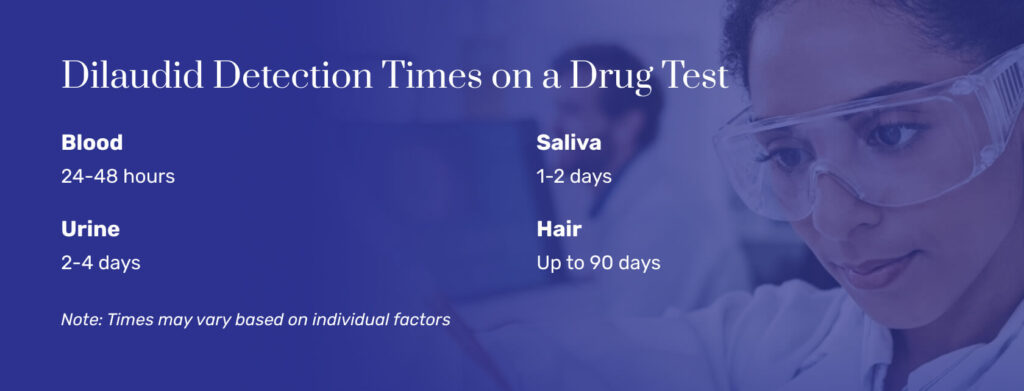This strong opioid drug is characterized by a half-life of approximately two to three hours. It is efficiently metabolized within 10 to 15 hours after it enters the system.
Dilaudid Half-Life
Once ingested, Dilaudid (hydromorphone), begins to be metabolized by the body and has a relatively short half-life of about two to three hours.[1] This means that approximately half of the drug will be eliminated from the body within three hours of being taken.
For example, if someone takes an 8 mg dose of Dilaudid, about two to three hours later, they would have around 4 mg remaining in their system. This would further reduce to about 2 mg after another two to three hours, and so on.
As the body continues to metabolize Dilaudid, its concentration in the bloodstream continually decreases. Usually, after around five half-lives (which translates to about 10 to 15 hours for Dilaudid), most of the drug is cleared from the system. However, the actual amount of time it takes to fully eliminate the drug from the system can vary, depending on individual factors like age, liver function, overall health, and other medications or substances being used.
One of the biggest reasons why the half-life of Dilaudid and how it works in the body is so important is because many people incorrectly assume that if they are no longer feeling the effects of the drug, it is no longer in their system. They then think they are free to take more of the drug.
After about one half-life, Dilaudid’s effects may no longer be felt by the user, but there is still about half a dose in the person’s system. If they take another dose too quickly, drink alcohol, or take another drug that is a central nervous system depressant, they could inadvertently trigger an overdose.
If you or someone you love has been prescribed Dilaudid by your doctor, it is essential that you follow their instructions precisely and do not take more of the drug or combine its use with another substance without first consulting your healthcare professional.

How Long Is Dilaudid Detectable on a Drug Test?
The amount of time that Dilaudid will be detectable on a drug test depends on the specific type of test used.
Urine
Dilaudid can typically be detected in urine for an estimated two to four days after use.[2] However, this timeframe may differ depending on an individual’s metabolism, how often they use Dilaudid or other opioids, and the amount consumed.
Saliva
Dilaudid can typically be detected in saliva for a shorter duration compared to urine, generally up to one to two days after use. Like urine, the exact detection time can vary based on individual factors.
Blood
Dilaudid has a shorter detection window in blood compared to urine. Drug use can typically be detected for 24 to 48 hours after its last administration. However, extended-release formulations might remain detectable for slightly longer due to the fact that they break down more slowing in the system over time.[3]
Hair
: Hair tests can reveal evidence of drug consumption over an extended period. Specifically, Dilaudid may remain detectable up to 90 days after using the drug, as its molecules penetrate the hair shaft, providing a historical record of drug use that is as long as the hair.
It’s important to note that drug tests can vary significantly based on the manufacturer and the type of test. Factors such as the test’s sensitivity and the efficacy of the components of the test can impact whether or not it will be accurate.
Additionally, the person administering the test and the lab that checks the results are fallible and can produce false positives or false negatives. For this reason, depending on the reason the drug test is needed, a positive urine test for Dilaudid may be followed up with a hair-based drug test to confirm results.


Dilaudid Addiction Treatment
Factors That Affect How Long Dilaudid Stays in Your System
Everyone is different, so even if two people take the same dose of Dilaudid at the same time and then drug test using the same type of test at the same time a few days later, they may have different results.
Some of the factors that can impact how quickly Dilaudid leaves the system include the following:
Metabolism
Everyone’s metabolism differs, which influences how fast their body processes drugs such as Dilaudid. People with faster metabolisms tend to eliminate the drug more rapidly than those with slower metabolisms.
Dosage and duration of Dilaudid use
How you use Dilaudid can have a direct impact on its presence in the body. Higher doses or prolonged use may increase its buildup and lengthen the time it remains in your system.
Frequency of use
Frequent Dilaudid use can result in the accumulation of its metabolites within your body, potentially prolonging detection.
Age
Because metabolic rates decline with age, a person’s age can alter how long Dilaudid stays in their system. This is particularly true for older individuals who take longer to process opioids like Dilaudid.[4]
Liver function
Dilaudid must be processed through the liver for elimination from the body. If liver health becomes impaired, it could prevent elimination of the drug, causing it to stay in the body for a longer period of time.
Kidney function
Dilaudid and its metabolites are excreted through the kidneys after metabolism, so any impairment to kidney function may slow its elimination from the body.
Body fat percentage
Dilaudid and other opioids have a tendency to accumulate in fatty tissues. People with higher body fat may retain the drug longer than those with lower body fat.
Hydration
Adequate hydration is vital in flushing drugs and their metabolites from the body quickly and safely, while insufficient hydration could hinder this process.
Drug interactions
Interference from other medicines or substances may disrupt Dilaudid’s metabolism and delay clearance rates, potentially prolonging its stay in the system.
Route of administration
How Dilaudid is administered (oral, intravenous, or intramuscular) may have an impactful influence on its absorption rate and elimination pattern.
Genetics
Genes can play an integral part in how Dilaudid is processed and excreted from your system, leading to individual variations.[5]
Follow Prescription Guidelines
Taking the time to understand how your body processes Dilaudid can have a profound impact on your ability to ensure that other medications are able to do their job effectively. This understanding can also help you to protect yourself from accidental overdose or accident and injury under the influence.
In most cases, if you take Dilaudid as prescribed by your doctor and report any side effects or negative issues you experience, you should be able to avoid any serious health concerns. However, if for any reason you feel that you may have taken a second dose of Dilaudid too soon or that you are experiencing a negative interaction between Dilaudid and another medication or substance that you have taken, call 911 for medical assistance.
Dilaudid misuse can result in a dangerous overdose, especially when combined with alcohol or other substances. Warning signs include slow or shallow breathing, severe drowsiness, confusion, or unconsciousness. If you or someone you love is struggling with Dilaudid addiction, seek professional help today to start the journey toward recovery at our New Jersey addiction treatment center.
- Abi Aad KR. & Derian, A. Hydromorphone. StatPearls Publishing. Published July 11, 2022. Accessed July 21, 2023.
- Gerberich, A. What drugs are likely to interfere with urine drug screens? University of Illinois Chicago. Published May 2021.
- Verstraete AG. Detection times of drugs of abuse in blood, urine, and oral fluid. Therapeutic Drug Monitoring. 2004;26(2):200-205.
- Naples JG, Gellad WF, Hanlon JT. The role of opioid analgesics in geriatric pain management. Clinics in Geriatric Medicine. 2016;32(4):725-735.
- Tadje M. Genetic variants influencing patient response to opioid therapy. ONS. Published July 1, 2015. Accessed July 26, 2023.
















